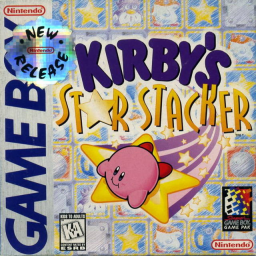This was one of my childhood games, and I've revisited it periodically over the years. Mostly the Time Attack mode (my record at the time of writing is 249). When I decided to check for speedruns, I was surprised to see that no one else seemed to have developed the same strategies I used for Time Attack. Not even avoiding star/hard blocks on the edges (more on that shortly), which feels so fundamental to me.
This might not be the optimal way to speedrun, just what I've developed on my own over the years... but that was enough for me to take most of this game's WRs in 1 or a few tries (aside from the pure-RNG Normal). So they're certainly an improvement over what all the other runners are doing, at the time of writing.
#1 Guideline
Avoid placing star/hard blocks in the edge columns!
If any star/hard blocks already exist on the edges, eliminate them whenever you get the chance.
Why is this so essential? Well, there are only a few ways to remove a star/hard block in an edge column:
- Placing a friend on top of the star/hard, either for an immediate vertical match or a chain later. Both of these consume multiple edge-column friends.
- Letting Dedede push the star/hard off the top of the screen. This is slow.
- Destroying it with a bomb. Bombs only spawn in certain levels, rarely line up with the star/hard block, and won't be enough if you have more than 1 star/hard block on the edge.
Edge star/hard blocks can't match bonus stars, so a chain is near-guaranteed to end when an edge star reaches row 1, unless you get a lucky row 2 match on a 6+ chain... And removing edge stars actively hurts chain potential since you also lose edge friends. Best to not place them in the first place.
I'm not saying to never place edge stars, but given how much they disrupt the stack's chaining potential, only do so if you have a good reason. Some examples on when to break this rule include:
- You've set up a good chain that relies on a specific friend+star/hard pair to initiate it, need to stall for that friend, and the edge is the best play you can make without breaking the setup early
- You only need a few more stars in the round (too little for a large chain to matter), and it's faster to place your friend+star/hard pair vertically than horizontally
- The stack is so high (e.g. some Insane starts) that placing the star/hard not on the edge would leave you at risk of game over, or at risk of being slowed down by a max-height column 2/5
Dedede
While Dedede RNG weights vary by level, the blocks follow a few rules that bypass the weights:
- Edge columns (1/6) always spawn friends.
- Other columns (2-5) always spawn friends if there's no friend already in the column. (This includes a 9-tall column with a friend on top-- the old friend despawns before forcing a new friend.)
This contributes to why edge friends are so useful for chaining-- Dedede won't interfere. Also, if you clear out all friends from columns 2-5, he'll always spawn a row full of friends, which tends to be a good chain initiator.
Meanwhile, if you leave friends in central columns, he tends to spawn star/hard blocks (or bomb blocks in certain levels) below them-- this is less good for chaining, since it means friends tend to match vertically in the edge columns (and remember, losing friends in edge columns means they're not used for extending bonus star chains).
As such, on higher difficulties (more Dedede bias toward non-friends), it's useful to stack friends on the edges, remove friends from the other columns.
On lower difficulties, where the friend rate is higher, and Dedede isn't always 2-turn (slower to wait for 3-turn Dedede), it can be more useful to try to set up vertical friend matches in center columns, meanwhile.
Dedede RNG note:
Dedede's friend generation isn't perfectly random. When all 6 blocks are friends (a common occurrence with this strategy), they tend to be one of a few fixed patterns!
Notably, ABABAC is fairly common (a great chain initiator on column 3, since it provides a 3-chain on its own, which also re-clears all central friends), but its mirror ABCBCB never occurs. (Neither does the substituted ABCBAC, which would be just as good as ABABAC.) There are a few other recurring patterns, like ABCBCA, ABCABC, and ABACBC, which aren't as useful for getting decent (3+) chains.
Since ABABAC is frequent, and uses the edge columns unequally, it can help to keep column 1 higher than column 6. For example, if you have an empty playing field, place a new friend on the left. It's even better if column 1's friends are aligned with column 6's, but offset 1 row higher. (Clearing out central friends and hoping for the ABABAC works best on higher difficulties, where friend+hard is the most common falling pair, since the hard block is enough to 3-chain on its own. To initiate the ABABAC chain with friend+friend or friend+star, you need another star block in column 2 or 4.)
I'd like to reverse-engineer this game's RNG sometime, but for now this is just by observation across years of playing this game-- and playing to the RNG trends still helps even if the RNG isn't fully documented.
Chaining
Bonus star values:
- 2 chain: 2 stars
- 3 chain: 4 stars
- 4 chain: 5 stars
- 5 chain: 6 stars
- 6+ chain: 12 stars
Bonus stars are the main source of score in this game. As evident from the nonlinear formula, 6-chain is the most important threshold, where it suddenly jumps to 12 stars.
The jump from 2 to 4 stars is also significant. 2-chains are slow. So slow they're often not even worth the time, if the chain ends at 2. Their bonus stars can still be good chain initiators, though. Especially on lower difficulties where double-friends are more common (place two matching friends slightly apart to catch the bonus stars, then try to 2-chain higher on the stack with a double-friend).
Mid-size chains without multiple rounds of bonus stars (e.g. a 5-chain with just a single set of 6 bonus stars at the end) are also rather slow compared to their star output.
Efficient stacking is also a consideration, though. Sometimes a simple 2-chain is worth it to improve the stack structure-- for example, it may clear out the central column friends, allowing for a chance at that ABABAC roll, or it may remove stars from the edge columns. Other times a larger chain might not be worth it, such as a chain that consumes an entire edge column's friends without producing many bonus stars.
When deciding whether to stack higher, or set off a chain the game offered: try to aim for chains that improve the stack structure, chains where the bonus stars produce a larger chain, or 6+ chains.
Misc mechanics
Finally, here are some random mechanics that might not be intuitive, along with some minor speed advice involving them.
• Any block placement can be reached with at most one rotation (A or B), and it's very rare to need both an A/B rotation and an up-swap. If you're rotating more than once, a faster input was possible!
• Crisis starts when column 3 and/or 4 is 7+ blocks tall. When in crisis, if Dedede's fist delay isn't already 3 or 0, it becomes 3 temporarily; this change in fist delay is what I call "crisis mode". Crisis mode ends 2 turns after both columns 3-4 are <7 blocks tall. If crisis mode ends as Dedede's fist pounds, the next fist cycle is still 3 turns; the cycle after that is back to 2 turns.
Crisis mode is generally bad for speed, since Dedede provides useful blocks for chaining... However, entering crisis mode intentionally to slow down Dedede can be useful sometimes: to prevent one of the side columns from reaching the top (if you need to match it from above), or to stall for the block pair you need to set off a good chain without risking Dedede breaking it. If you enter crisis from your own block pair when Dedede's fist is not visible, you even get a 4th turn (since the countdown is set to 3, after 1 of 2 turns already elapsed).
• Any blocks off the top of the screen instantly despawn. Aside from Dedede pushing blocks off the top, you can place a pair vertically on an 8-high column to despawn the top block. This occurs even in the center columns!
This can be useful when the stack is very high (e.g. some Insane levels) to place only 1 block instead of 2... or useful when matching an 8-high column, to avoid the slow delay from dropping the other block to a much lower column.
• The first rotation is always around the left block. As such, it's easier to place a vertical pair on column 1 (where you can hold left, then rotate) than column 6, where you need to rotate before you reach it (might not be possible if the column is too tall at high speed).
This also means column 3 is generally the fastest column to place a block pair. If you have multiple choices to win a level, or you need to waste a pair (say, only a few stars are remaining and the next pair will win) and all columns are about the same height, column 3 is often fastest... however, at low gravity it might be faster to place on the tallest column.
• The A button rotation is below the block pair; the B button rotation is above the block pair. If both rotations would be equally useful for stacking, A is slightly faster than B, since you reach the stack sooner. However, when stacking on a very tall column 6 (e.g. the walls of hard blocks in Super Hard 9), a B rotation (possibly followed by an up-swap) might allow you to place your pair on top, when an A rotation wouldn't.
• When placing a block pair horizontally on columns of different heights, the remaining block falls slower than manually dropping it-- so it's generally faster to place blocks vertically despite the extra rotation. When stacking friends on the edge, friend+star/hard pairs need to be placed horizontally (otherwise the star/hard would be on the edge), so this can affect which edge is the faster choice.
This also discourages letting column 2/5 grow too high. Those columns naturally tend to build up star/hard blocks from edge friend stacking, and from Dedede, but it's a good idea to match them vertically occasionally. And if you have excess stars to place (e.g. the annoying double-star/hard block pairs), generally best to place them in column 3 and/or 4.
I hope this advice helps anyone who might speedrun this game in the future. It'd be nice to have some competition.
Note: These guidelines are specific to the GB version. The SNES version has different physics and RNG trends, and a 12-high field size that tends to cause accidental large chains (especially with its lack of the GB version's Dedede bias against friends, in central columns that already contain friends), so I wouldn't expect most of the advice to be applicable. Avoiding star/hard blocks on the edges is likely still important on SNES, though, since chaining is the same.




